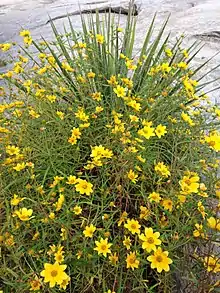Helianthus porteri
Helianthus porteri is a species of sunflower known by the common names Porter's sunflower,[2] Stone Mountain Daisy[3] and Confederate daisy. It is native to the southeastern United States, such as Alabama and Georgia, but has been introduced to granite outcrop areas in North Carolina where it is aggressively weedy.[4][5]
| Confederate daisy | |
|---|---|
 | |
| Helianthus porteri on Stone Mtn. | |
| Scientific classification | |
| Kingdom: | |
| (unranked): | |
| (unranked): | |
| (unranked): | |
| Order: | |
| Family: | |
| Genus: | |
| Species: | H. porteri |
| Binomial name | |
| Helianthus porteri (A.Gray) Pruski 1998 not (A.Gray) Heiser 1978 (1978 name not validly published) | |
| Synonyms[1] | |
| |
Helianthus porteri grows on thin soils on and around flat rock granite and gneiss outcrops.[6] It is an annual herb up to 100 cm (40 inches) tall. One plant usually produces 5 or more flower heads, each containing 7 or 8 yellow ray florets surrounding 30 or more yellow disc florets.[7][8]
The species is named for Thomas Conrad Porter.[9]
References
- The Plant List, Helianthus porteri (A.Gray) Pruski
- "Helianthus porteri". Natural Resources Conservation Service PLANTS Database. USDA. Retrieved 6 July 2015.
- Scott Ranger's Nature Notes http://scottranger.com/helianthus-porteri-confederate-daisy.html
- Biota of North America Program 2014 county distribution map
- Weakley AS. 2015. Flora of the southern and mid‐Atlantic states. University of North Carolina Herbarium, North Carolina Botanical Garden, Chapel Hill, NC, USA. [WWW document] URL http://www.herbarium.unc.edu/flora.htm
- Scott Ranger's Nature Notes http://scottranger.com/helianthus-porteri-confederate-daisy.html
- Flora of North America, Helianthus porteri (A. Gray) Pruski, 1998. Confederate daisy
- Blake, Sydney Fay 1918. Contributions from the Gray Herbarium of Harvard University 54: 114–115, as Viguiera porteri
- Heller, A. A. (1901). "Thomas Conrad Porter". The Plant World. 4 (7): 130–131. ISSN 0096-8307. JSTOR 43475709.
External links
| Wikimedia Commons has media related to Helianthus porteri. |
- photo of herbarium specimen at Missouri Botanical Garden, collected in Georgia in 1846, isotype of Rudbeckia porteri/Viguiera porteri/Helianthus porteri
- Scott D. Gevaert, Jennifer R. Mandel, John M. Burke, and Lisa A. Donovan. 2013. High Genetic Diversity and Low Population Structure in Porter’s Sunflower (Helianthus porteri). Journal of Heredity 2013:104(3):407–415 doi:10.1093/jhered/est009
- Plant Life of the Monastery of the Holy Spirit by Jim Allison
- Alabama Plant Atlas, Helianthus porteri
This article is issued from Wikipedia. The text is licensed under Creative Commons - Attribution - Sharealike. Additional terms may apply for the media files.